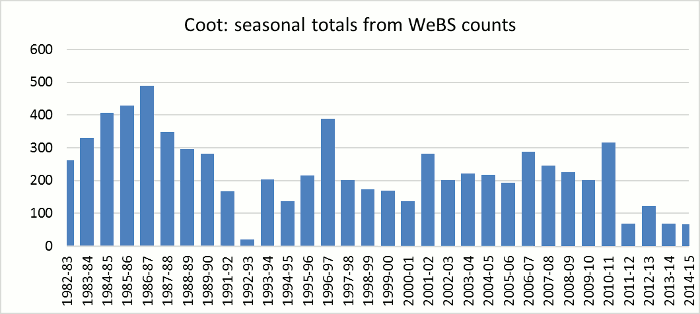Breeding resident, winter visitor and passage migrant
Mathew (1894) stated that the Coot was confined as a breeder to the few large ponds in the county and that it was a regular, but not numerous, winter visitor. Lockley et al. (1949) mention only a few breeding localities and agreed that it was a winter visitor in small numbers, but that "thousands" appeared on the Cleddau Estuary in the severe winters of 1933/34 and 1946/47. No large visitations like that have been recorded since, not even during the arctic winters of 1962 and 1963 when groups of up to ten were forced onto the saltings.
The Coot is now widely distributed as a breeding bird, the creation of farm irrigation reservoirs having presented it with the opportunity to spread beyond the long established ponds. The 1984-1988 Breeding Birds Survey estimated a population of about 75 breeding pairs.
Numbers are augmented during the winter, when Coots can be found scattered over many small waters with larger concentrations at Llysyfran reservoir, Pembroke Mill Ponds and particularly Bosherston Pools, where 200-300 normally gather and the county maximum of 368 occurred on 14 January 1986. Numbers build up from mid-September to peak in January and February and then dwindle during March. Coots occasionally occur on the islands of Skokholm and Skomer in July and August, probably part of post-breeding dispersal and of a local nature, and more rarely in October, when the birds concerned could be migrants from further afield. Ringing recoveries show that Coots come from as far away as Latvia and Jutland and that some pass on to Ireland.

Fieldwork 1984-88 (based on 478 tetrads)
Red = breeding confirmed = 18
Yellow = breeding possible = 8
Total tetrads in which registered = 26 (5.4%)
Donovan J.W. & Rees G.H (1994), Birds of Pembrokeshire
 Tuesday, January 26, 2016 at 12:27PM
Tuesday, January 26, 2016 at 12:27PM 
 Pembrokeshire Avifauna committee | Comments Off |
Pembrokeshire Avifauna committee | Comments Off | 





